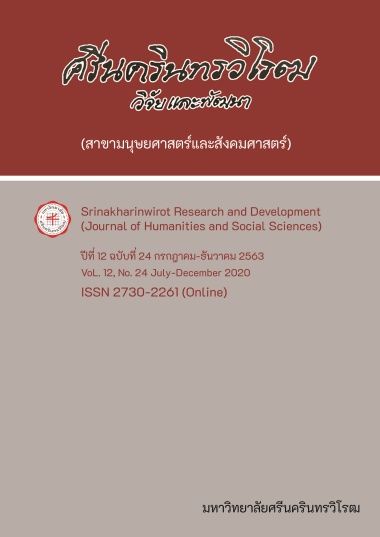อิทธิพลของความคล้ายคลึงเชิงรูปลักษณ์และการรับรู้การควบคุมได้ ที่มีผลต่อการรับรู้ความเหมือนมนุษย์ ความเชื่อใจ และการยอมรับต่อหุ่นยนต์ EFFECTS OF PERCEIVED PHYSICAL APPEARANCE SIMILARITY AND CONTROLLABILITY ON PERCEIVED ANTHROPOMORPHISM, TRUST, AND ACCEPTANCE TOWARDS ROBOTS
คำสำคัญ:
ทฤษฎี S-E-E-K, ความคล้ายคลึงเชิงรูปลักษณ์, การรับรู้การควบคุมได้, ความเหมือนมนุษย์, ความไว้วางใจ, การยอมรับ, หุ่นยนต์บทคัดย่อ
งานวิจัยนี้มีจุดประสงค์เพื่อศึกษาอิทธิพลของการรับรู้ความเหมือนมนุษย์ที่มีต่อความไว้วางใจ และการยอมรับหุ่นยนต์ตามแนวคิดทฤษฎี S-E-E-K ที่นำมาใช้สร้างกรอบแนวคิดหลักในการวิจัยนี้ โดยมีปัจจัยทางด้านความคล้ายคลึงเชิงรูปลักษณ์เป็นตัวแปรต้น การรับรู้การควบคุมได้เป็นตัวแปรกำกับ และแรงจูงใจ ทางสังคมเป็นตัวแปรควบคุม กลุ่มตัวอย่าง คือ นิสิต จำนวน 200 คน อายุระหว่าง 18-25 ปี ใช้การสุ่มอย่างเป็นระบบร่วมกับการสุ่มอย่างง่ายเข้าหนึ่งใน 4 เงื่อนไข โดยให้ผู้เข้าร่วมการวิจัยดูรูปภาพและอ่านข้อความคุณสมบัติของหุ่นยนต์ที่มีการจัดกระทำให้มีความคล้ายคลึงมนุษย์และพฤติกรรมที่คาดเดา/ควบคุมได้ของหุ่นยนต์ที่แตกต่างกันในแต่ละเงื่อนไข จากนั้นตอบแบบสอบถามการรับรู้ความเหมือนมนุษย์ ความไว้วางใจหุ่นยนต์
การยอมรับหุ่นยนต์ ผลจากการวิเคราะห์เส้นทางพบว่า ความคล้ายคลึงเชิงรูปลักษณ์มีผลต่อการรับรู้ความเหมือนมนุษย์ที่มีต่อหุ่นยนต์อย่างมีนัยสำคัญทางสถิติ โดยในเงื่อนไขที่มีการรับรู้การควบคุมและคาดเดาไม่ได้ทำให้อิทธิพลของความคล้ายคลึงเชิงรูปลักษณ์ที่มีต่อการรับรู้ความเหมือนมนุษย์เพิ่มมากขึ้น ยิ่งไปกว่านั้นหุ่นยนต์ที่มีความคล้ายคลึงมนุษย์สูง และบุคคลไม่สามารถควบคุมหรือคาดเดาพฤติกรรมของหุ่นยนต์ได้ ทำให้บุคคลรู้สึกว่าหุ่นยนต์มีความเหมือนมนุษย์มากขึ้น ซึ่งส่งผลต่อความไว้วางใจรวมถึงการยอมรับหุ่นยนต์
Downloads
เอกสารอ้างอิง
[2] De Ruyter, B., Saini, P., Markopoulos, P., & Van Breemen, A. (2005). Assessing the effects of building social intelligence in a robotic interface for the home. Interacting with computers, 17(5), 522-541.
[3] Tung, F.W. (2016). Child perception of humanoid robot appearance and behavior. International Journal of Human-Computer Interaction, 32(6), 493-502.
[4] Rotter, J.B. (1980). Interpersonal trust, trustworthiness, and gullibility. American Psychologist, 35, 1-7.
[5] Park, E., Jenkins, Q., & Jiang, X. (2008). Measuring trust of human operators in new generation rescue robots. In Proceedings of the JFPS International Symposium on Fluid power, V. 2008. No. 7-2. pp. 489-492. The Japan Fluid Power System Society.
[6] Piçarra, N., & Giger, J.C. (2018). Predicting intention to work with social robots at anticipation stage: Assessing the role of behavioral desire and anticipated emotions. Computers in Human Behavior, 86, 129-146.
[7] Waytz, A., Heafner, J., & Epley, N. (2014). The mind in the machine: Anthropomorphism increases trust in an autonomous vehicle. Journal of Experimental Social Psychology, 52, 113-117.
[8] PwC. (2017, June). What doctor? Why AI and robotics will define New Health. Retrieved from https://www.pwc.com/gx/en/industries/healthcare/publications/ai-robotics-new-health/ai-robotics-new-health.pdf
[9] Choi, J. G., & Kim, M. (2009). The usage and evaluation of anthropomorphic form in robot design. In Design Research Society Conference 2008, Sheffield Hallam University, Sheffield, UK., 16-19 July 2008.
[10] Hancock, P.A., Billings, D.R., Schaefer, K.E., Chen, J.Y., De Visser, E.J., & Parasuraman, R. (2011). A meta-analysis of factors affecting trust in human-robot interaction. Human factors, 53(5), 517-527.
[11] Gessl, A.S., Schlögl, S., & Mevenkamp, N. (2019). On the perceptions and acceptance of artificially intelligent robotics and the psychology of the future elderly. Behaviour & Information Technology, 38(11), 1068-1087.
[12] Epley, N., Waytz, A., & Cacioppo, J.T. (2007). On seeing human: a three-factor theory of anthropomorphism. Psychological review, 114(4), 864-886.
[13] Epley, N., Waytz, A., Akalis, S., & Cacioppo, J.T. (2008). When we need a human: Motivational determinants of anthropomorphism. Social cognition, 26(2), 143-155.
[14] Waytz, A., Morewedge, C.K., Epley, N., Monteleone, G., Gao, J.H.; and Cacioppo, J.T. (2010). Making sense by making sentient: effectance motivation increases anthropomorphism. Journal of personality and social psychology, 99(3), 410-435.
[15] Mori, M. (1970). The uncanny valley. Energy, 7(4), 33-35.
[16] Erikson, E.H. (1968). Identity, youth, and crisis. New York: Norton.
[17] Dillon, A., & Morris, M.G., (1996). User Acceptance of New Information Technology: Theories and Models. In Annual Review of Information Science and Technology. Medford, NJ: Information Today.
[18] Ajzen, I. (1991). The theory of planned behavior. Organizational behavior and human decision processes, 50(2), 179-211.
[19] Davis, F.D. (1989). Perceived usefulness, perceived ease of use, and user acceptance of information technology. MIS Quarterly, 13(3), 319-340.
[20] Venkatesh, V., Morris, M.G., Davis, G.B., & Davis, F.D. (2003). User acceptance of information technology: Toward a unified view. MIS Quarterly, 27(3), 425-478.
[21] Schroer, W.J. (2008). Generations X, Y, Z and the others. The Journal of the Household Goods Forwarders Association of America, 40, 9-11.
[22] Hair, J.F., Black, W.C., Babin, B.J., & Anderson, R.E. (2010). Multivariate data analysis: A global perspective. NJ: Pearson Prentice Hall.
[23] Hays, R.D., & DiMatteo, M.R. (1987). A short-form measure of loneliness. Journal of personality Assessment, 51(1), 69-81.
[24] Russell, D., Peplau, L.A., & Cutrona, C.E. (1980). The revised UCLA Loneliness Scale: concurrent and discriminant validity evidence. Journal of personality and social psychology, 39(3), 472-480.
[25] Jian, J.Y., Bisantz, A.M., & Drury, C.G. (2000). Foundations for an empirically determined scale of trust in automated systems. International Journal of Cognitive Ergonomics, 4(1), 53-71.
[26] Nomura, T., Kanda, T., & Suzuki, T. (2006). Experimental investigation into influence of negative attitudes toward robots on human–robot interaction. Ai & Society, 20(2), 138-150.
[27] Gong, L. (2008). How social is social responses to computers? The function of the degree of anthropomorphism in computer representations. Computers in Human Behavior, 24(4), 1494-1509.
[28] Dawes, R.M., & Mulford, M. (1996). The false consensus effect and overconfidence: Flaws in judgment or flaws in how we study judgment?. Organizational Behavior and Human Decision Processes, 65(3), 201-211.
[29] Rotter, J.B. (1967). A new scale for the measurement of interpersonal trust. Journal of Personality, 35, 651-665.
ดาวน์โหลด
เผยแพร่แล้ว
รูปแบบการอ้างอิง
ฉบับ
ประเภทบทความ
สัญญาอนุญาต
วารสารศรีนครินทรวิโรฒวิจัยและพัฒนา สาขามนุษยศาสตร์และสังคมศาสตร์ อยู่ภายใต้การอนุญาต Creative Commons Attribution-NonCommercial-NoDerivs 4.0 International (CC-BY-NC-ND 4.0) เว้นแต่จะระบุไว้เป็นอย่างอื่น โปรดอ่านหน้านโยบายของวารสารสำหรับข้อมูลเพิ่มเติมเกี่ยวกับการเข้าถึงแบบเปิด ลิขสิทธิ์ และการอนุญาต



